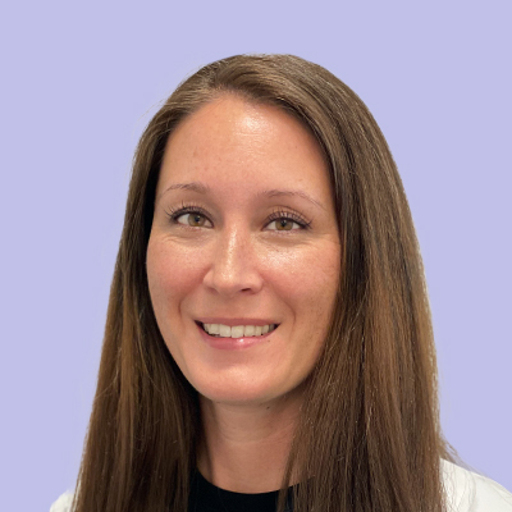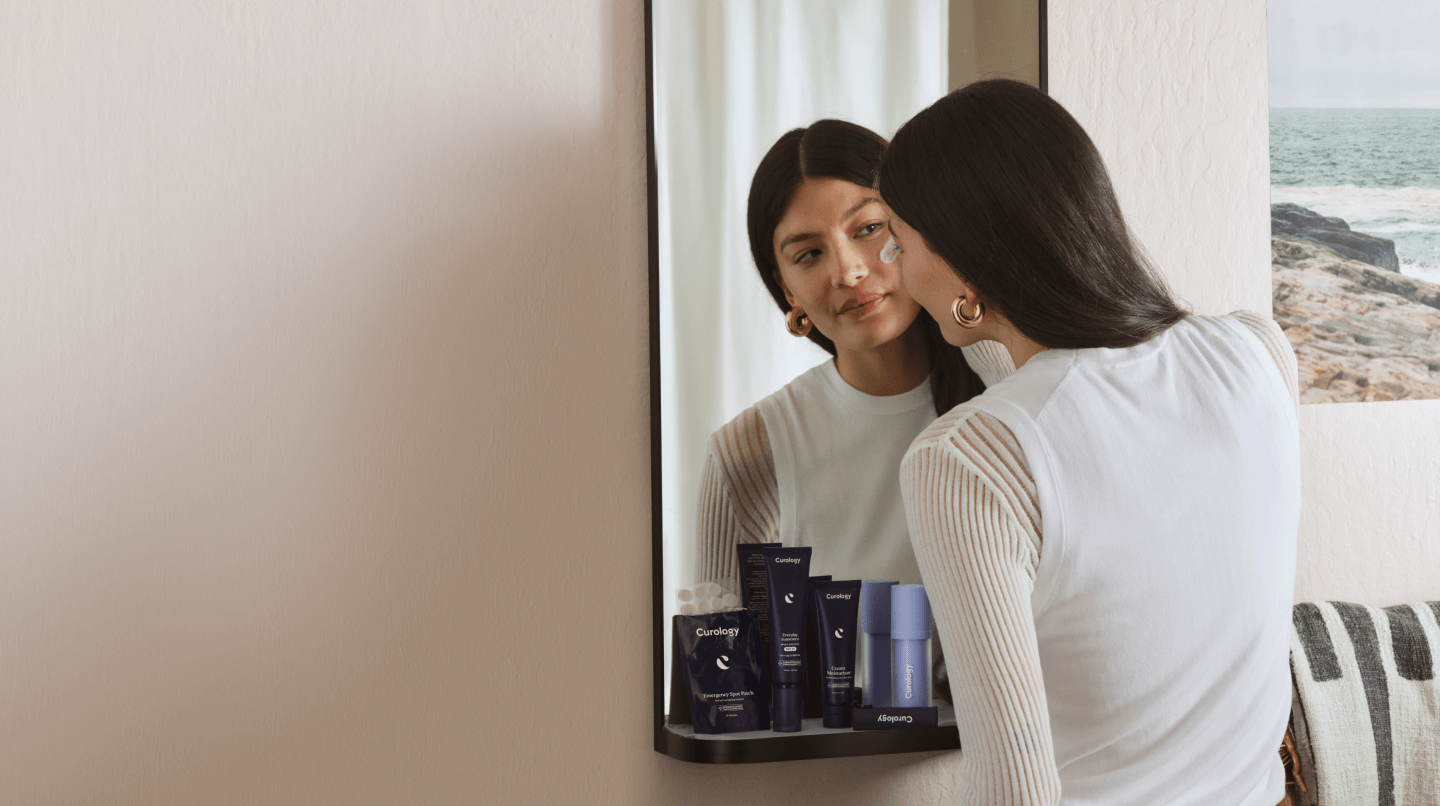How it works:
Share your skin goals and snap selfies
Your dermatology provider prescribes your formula
Apply nightly for happy, healthy skin
How it works:
How it works:
Share your skin goals and snap selfies
Your dermatology provider prescribes your formula
Apply nightly for happy, healthy skin
How it works:
Tretinoin for wrinkles: What can this retinoid do?
Here’s how this powerful retinoid can smooth wrinkles and brighten your complexion.



Here at Curology, we believe in celebrating life’s milestones to the fullest, birthday after birthday. Even so, we understand that some people may want to minimize the appearance of signs of aging, which include the fine lines and wrinkles that naturally appear as skin loses its firmness and elasticity over time.
Enter: tretinoin. When it comes to superstar skincare ingredients, tretinoin cream or gel is one of the best ways to help reduce the appearance of wrinkles. Here’s everything you need to know about the signs of aging and why the experts recommend tretinoin for wrinkles.
What causes wrinkles?
Over time, those fine lines you might spy in the mirror can turn into wrinkles—deeper lines and creases in your skin. Wrinkles typically occur due to repeated muscle movement, which is why they often appear between and around the eyes and on the forehead. Several factors may contribute to the formation of wrinkles, including the following:
Repeated facial muscle contractions: Smile lines and crow’s feet can naturally develop with age (and plenty of fun moments in life).
Getting older: The passage of time contributes to intrinsic aging, which is caused by factors outside of our control.
Genetics: How we form wrinkles may be partially related to our genetics—another facet of intrinsic aging.¹
Sun damage: The primary cause of extrinsic aging—aging caused by factors within our control—is exposure to the sun’s UV rays.²
Smoking: Smoking is another extrinsic aging factor that contributes to facial wrinkling.³
Stress: High-stress levels are an extrinsic aging factor that may contribute to wrinkles.⁴
Diet: One study showed that eating a healthy, fruit-rich diet may be associated with having fewer facial wrinkles in women.⁵
So, why do these factors contribute to wrinkles? It may be related to these factors’ effects on collagen (the skin’s support system) and elastin (which helps the skin bounce back). Fine lines and wrinkles are linked to decreased collagen and elastin in the skin.⁶ To prolong your skin’s firmness and elasticity, it may help to identify the factors contributing to your wrinkles and take good care of your skin, ultimately slowing the appearance of the signs of aging.
What is tretinoin? How does it work?
Tretinoin is considered by many dermatology providers to be the gold standard in topical anti-aging treatment. Known by brand names including Retin-A and Tretin-X, tretinoin is a potent retinoid derived from vitamin A. It helps repair skin damage and stimulates the growth of new, healthy skin cells.⁷
Tretinoin promotes a more youthful, glowy appearance by increasing the skin’s collagen production and cell turnover rate. It also may improve the appearance of fine lines and wrinkles, smooth your skin’s texture, even out your skin tone, and reduce hyperpigmentation (dark spots).⁸ Long-term use of tretinoin for wrinkles is usually necessary to see results, as it can take a while to do its job.
Tretinoin may be a good choice for you if you’re looking to reduce the appearance of the signs of aging and even treat acne.

Tips for using tretinoin to reduce wrinkles
If you’re using tretinoin for anti-aging goals, patience is essential. When starting tretinoin, it’s generally recommended to use a pea-sized amount two to three times weekly, gradually working your way up to nightly use as tolerated.
When you’re starting tretinoin for wrinkles, strength is an important factor—we recommend discussing your needs with a dermatology provider, so they can prescribe a strength that’s right for you. Tretinoin concentration typically ranges from 0.01%-0.1%, but Curology providers can prescribe lower and higher strengths.
Here are some tips to help make the most of tretinoin:
Use it consistently
Although some people may begin seeing improvement quickly, the amount of time it takes to see a change varies between individuals. It takes time for the formation of new collagen, and it may take many months to see the benefits. The best results are typically seen with consistent nightly use. If your skin will not tolerate daily application, start by applying it a few times weekly and work up from there as tolerated.
Protect your skin from the sun
We always recommend applying sunscreen daily, but sun protection is all the more important when you’re using tretinoin. This ingredient may increase your skin’s sensitivity to UV rays,⁹ making you more likely to experience sunburn. Our experts suggest using a broad-spectrum sunscreen that’s SPF 30 or higher and reapplying based on your product’s instructions (typically every two hours). Grab a wide-brimmed hat while you’re at it for extra protection.
Be mindful of side effects
Tretinoin is a powerful prescription ingredient that may cause some temporary side effects.¹⁰ It’s beneficial to be aware before you begin treatment so extra dryness and irritation don’t come as a surprise. We’ll discuss the common side effects and how to handle them below.
Potential side effects of tretinoin
Whether you’re just starting your topical tretinoin journey or taking a step up to a higher strength, you may experience a few potential side effects.¹¹ These side effects are a great reason to be especially careful if you’re considering using tretinoin for wrinkles under eyes, as the skin there tends to be more delicate than the rest of your face. Potential side effects include the following:
Irritation
Burning¹²
Scaling
Dryness or peeling
Redness
Increased skin sensitivity
Purging (temporary increase in acne-like breakouts)
Purging may be due to how tretinoin increases your skin cell turnover rate. A temporary acne flare may occur as pores become clogged by the exfoliated skin cells. Though frustrating, it’s worth sticking out.
If you’re experiencing significant or worsening side effects, get in touch with your dermatology provider. They may recommend a different product, strength, or application frequency to help your skin adjust. If you’re pregnant or breastfeeding, skip the retinoids altogether.¹³
If you’re worried about these potential side effects of tretinoin, we have a few tips to help you manage them:
Before applying tretinoin, use your fingertips to wash your face with a gentle cleanser—avoid washcloths or scrubs.
After washing your face, wait at least 10 minutes to apply your tretinoin. Applying it on a completely dry face can help minimize potential irritation.
Use only a pea-sized amount of formula at a time.
Try applying your moisturizer before your tretinoin. This is called buffering.
Try mixing your tretinoin with an equal amount of moisturizer in the palm of your hand before applying it.

Personalized skincare from Curology
If you’re looking for accessible care for acne, rosacea, or anti-aging concerns, Curology is here for you. Our consultation process is one option to get prescription-strength skincare to fight the signs of aging. Just snap a few selfies to show us what your skin is like, and if you’re a good fit, we will pair you with one of our licensed, in-house dermatology providers. They’ll work with you to create a custom anti-aging treatment plan with products containing active ingredients like tretinoin.*
Curology’s full line of non-comedogenic, dye-free, and paraben-free skincare products are made to keep your skin happy and healthy. The best part? Your subscription includes any additional products recommended by your dermatology provider, such as cleansers, moisturizers, sunscreen, and more. Get started on your journey to healthier skin by signing up today.
FAQs
Several factors may contribute to the formation of wrinkles, including the following:
Repeated facial muscle contractions: Smile lines and crow’s feet can naturally develop with age (and plenty of fun moments in life).
Getting older: The passage of time contributes to intrinsic aging, which is caused by factors outside of our control.
Genetics: How we form wrinkles may be partially related to our genetics—another facet of intrinsic aging.
Sun damage: The primary cause of extrinsic aging—aging caused by factors within our control—is exposure to the sun’s UV rays.
Smoking: Smoking is another extrinsic aging factor that contributes to facial wrinkling.
Stress: High stress levels are an extrinsic aging factor that may contribute to wrinkles.
Diet: One study showed that eating a healthy, fruit-rich diet may be associated with having fewer facial wrinkles in women.
Tretinoin is considered by many dermatology providers to be the gold standard in topical anti-aging treatment. Known by brand names including Retin-A and Tretin-X, tretinoin is a potent retinoid derived from vitamin A. It helps repair skin damage and stimulates the growth of new, healthy skin cells.
P.S. We did the homework so you don’t have to:
Farage, M. A., et al. Intrinsic and Extrinsic Factors in Skin Ageing: A Review.International Journal of Cosmetic Science. (2008).
Zhang S, Duan E. Fighting against Skin Aging: The Way from Bench to Bedside. Cell Transplant. (May 2018).
Farage, M. A., et al. Intrinsic and Extrinsic Factors in Skin Ageing: A Review.International Journal of Cosmetic Science. Ibid.
Chen Y, Lyga J. Brain-skin connection: stress, inflammation and skin aging. Inflamm Allergy Drug Targets. (2014).
Jacobs, L., et al. A healthy diet in women is associated with less facial wrinkles in a large Dutch population-based cohort. Journal of the American Academy of Dermatology. (2019).
Al-Atif H. Collagen Supplements for Aging and Wrinkles: A Paradigm Shift in the Fields of Dermatology and Cosmetics. Dermatol Pract Concept. (2022 January 1).
Mukherjee1, Siddharth, et al. Retinoids in the treatment of skin aging:an overview of clinical efficacyand safety.Clinical Interventions in Aging. (2006).
Mukherjee1, Siddharth, et al. Retinoids in the treatment of skin aging:an overview of clinical efficacyand safety.Clinical Interventions in Aging. Ibid.
Retinoid or retinol?American Academy of Dermatology. (n.d.).
Mukherjee1, Siddharth, et al. Retinoids in the treatment of skin aging:an overview of clinical efficacyand safety.Clinical Interventions in Aging. Ibid.
Baldwin, H.E., et al. 40 Years of topical tretinoin use in review.Journal of Drugs in Dermatology. (2013).
Mukherjee1, Siddharth, et al. Retinoids in the treatment of skin aging:an overview of clinical efficacyand safety.Clinical Interventions in Aging. Ibid.
Mukherjee1, Siddharth, et al. Retinoids in the treatment of skin aging:an overview of clinical efficacyand safety.Clinical Interventions in Aging. Ibid.
Erin Pate is a board-certified Family Nurse Practitioner at Curology. She earned her Masters of Science in Nursing at Florida Atlantic University in Boca Raton, FL.
* Subject to consultation. Subscription is required. Results may vary.

Curology Team

Erin Pate, NP-C
Related Articles
The 5 best chemical exfoliators for glowing skinWhich tretinoin is right for you, according to Vogue? How to help stop a rash from spreading, according to skin experts How to treat atrophic scars: Here’s what you need to knowA simple guide to skincare for menPopular Articles
Ask Curology: Is my cold breaking me out?Slugging: The dermatologist-approved skincare hack going viral on TikTokTretinoin vs retinol: What’s the difference?How to create a self-care routine that actually sticksYour 2023 skincare horoscopeTry prescription skincare
Get routine essentials


Face what’s next with Future-ProofRx
Face what’s next with Future-ProofRx
- Skin texture
- Fine lines
- Wrinkles
- Dark spots
- Dullness
$29.95/month